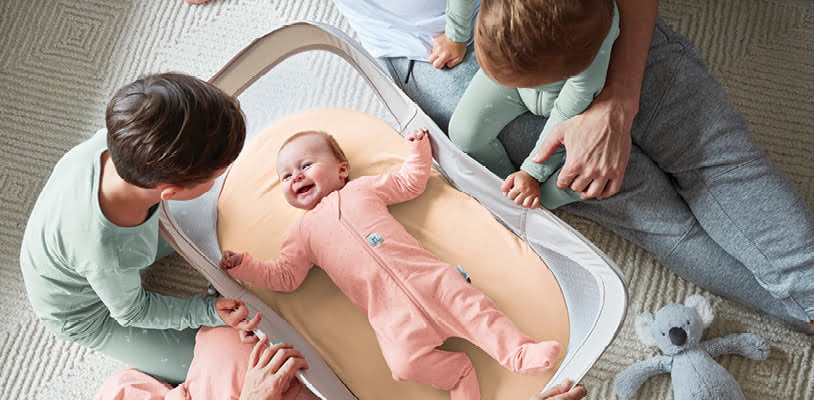Importance of Maintaining Sleep Routines While Traveling
Maintaining your baby’s sleep routine while traveling is crucial for their comfort and well-being. Consistent sleep patterns help your baby feel secure and rested, reducing fussiness and ensuring a smoother travel experience for the whole family. This article provides comprehensive tips to help you navigate the challenges of traveling with a baby while keeping their sleep routine intact.
Challenges of Traveling with a Baby
Traveling with a baby presents unique challenges, including disruptions to their sleep schedule, adjusting to new environments, and managing the logistics of travel. These challenges can lead to increased stress for both parents and baby, making it essential to plan and prepare adequately.
Overview of Tips and Strategies
This article covers a wide range of tips and strategies to help you maintain your baby’s sleep routine while traveling. From planning and packing to handling sleep disruptions and managing time zone changes, you’ll find practical advice to make your journey more enjoyable and restful for everyone involved.
Preparing for the Trip
Planning Ahead
Effective planning is the cornerstone of successful travel with a baby. Start by researching your destination and understanding the accommodations and amenities available. Consider the sleep environment and how you can replicate your baby’s home sleep conditions while on the road.
Choosing Baby-Friendly Accommodations
When booking accommodations, prioritize baby-friendly options. Look for hotels or rentals that offer cribs, blackout curtains, and quiet rooms. Check reviews from other parents to ensure the place is truly suitable for babies and offers a conducive sleep environment.
Packing Essentials for Baby’s Sleep
Packing the right sleep essentials is crucial. Include familiar items such as your baby’s favorite blanket, sleep sack, or stuffed animal. Don’t forget portable cribs or playards, white noise machines, and blackout curtains to recreate a familiar sleep environment.
Creating a Travel Checklist
A detailed travel checklist can ensure you don’t forget any important items. Include all sleep essentials, travel gear, and a list of baby’s regular bedtime routine steps. This checklist will help you stay organized and prepared for any situation.
Travel Modes and Sleep Considerations
Traveling by Car
Tips for Car Seat Safety and Comfort
Ensure your baby’s car seat is installed correctly and is comfortable for long drives. Use neck supports and soft padding to make the seat cozy. Take regular breaks to allow your baby to stretch and prevent discomfort.
Managing Long Drives
Plan your drives around your baby’s nap schedule. Try to start the journey when your baby is due for a nap to maximize their sleep during the drive. Bring along their favorite lullabies or white noise to help them fall asleep.
Ensuring Safe Sleep in the Car
Avoid letting your baby sleep in a car seat for extended periods when the car is not moving. Upon arrival at rest stops, transfer your baby to a flat, safe sleep surface to avoid the risks associated with sleeping in a car seat.
Traveling by Plane
Booking Flights with Babies in Mind
Choose flight times that align with your baby’s sleep schedule. Night flights can be beneficial as they coincide with natural sleep times. Booking a bulkhead seat can provide extra space for comfort.
Airport Navigation and Baby Care
Arrive at the airport early to allow ample time for check-in and security procedures. Use a baby carrier to keep your hands free and maintain close contact with your baby, which can be soothing for them.
In-Flight Sleep Tips for Babies
During the flight, use a baby carrier or travel bassinet to create a cozy sleep environment. Keep your baby’s bedtime routine as consistent as possible by bringing along familiar sleep items and maintaining feeding schedules.
Traveling by Train or Bus
Pros and Cons of Train and Bus Travel
Train and bus travel can offer more flexibility and space than planes or cars. However, they may also come with unique challenges such as frequent stops and less control over the environment.
Ensuring Baby’s Comfort and Sleep
Choose seats that offer space and privacy. Use curtains or blankets to create a dark and quiet space for your baby to sleep. Bring along all necessary sleep items and adhere to their routine as closely as possible.
Handling Travel Interruptions
Travel interruptions are inevitable. Plan for these by having a flexible schedule and extra supplies. Be prepared to adjust your plans to accommodate your baby’s needs and maintain their comfort.

Maintaining Sleep Routines on the Go
Importance of Consistency
Consistency is key to maintaining your baby’s sleep routine while traveling. Stick to their regular sleep schedule as closely as possible, even if it means adjusting your plans. Consistent nap times and bedtime help signal to your baby that it’s time to sleep, regardless of the environment.
Replicating Home Sleep Environment
Recreate your baby’s home sleep environment to help them feel secure and relaxed. Use familiar items like their crib sheet, favorite stuffed animal, and white noise machine. This familiarity can ease the transition and help your baby sleep better.
Establishing a Portable Bedtime Routine
Establish a portable bedtime routine that can be followed anywhere. This could include a bath, storytime, and lullabies. Keeping the routine consistent, even in a different setting, helps signal to your baby that it’s time to sleep.
Managing Naps While Traveling
Managing naps on the go can be challenging but is crucial for maintaining overall sleep health. Plan activities around your baby’s nap schedule and use a baby carrier or stroller to allow for naps on the move. Ensure your baby gets the rest they need to avoid overtiredness.
Handling Time Zone Changes
Gradual Adjustment Before Travel
If you’re traveling across time zones, gradually adjust your baby’s sleep schedule a few days before departure. Shift their bedtime and wake-up time by 15-30 minutes each day towards the new time zone to help ease the transition.
Managing Jet Lag in Babies
Jet lag can affect babies just as much as adults. Upon arrival, spend time outdoors in natural light to help reset their internal clock. Stick to the local time zone for meals and sleep times as much as possible.
Synchronizing Baby’s Schedule with New Time Zone
Once you arrive at your destination, immediately adjust your baby’s schedule to the new time zone. This means following the local times for meals, naps, and bedtime. Consistency will help your baby adapt more quickly.
Tips for Easing the Transition
Be patient and flexible as your baby adjusts to the new time zone. Keep their bedtime routine consistent and offer extra comfort and reassurance. It may take a few days for your baby to fully adjust, so be prepared for some temporary sleep disruptions.
Sleep-Friendly Travel Gear
Portable Cribs and Playards
Invest in a good-quality portable crib or playard that is easy to set up and provides a safe sleep space for your baby. Familiarize your baby with the portable crib before the trip to make the transition smoother.
White Noise Machines and Apps
White noise machines or apps can help drown out unfamiliar sounds and create a consistent sleep environment. Use the same white noise your baby is accustomed to at home for the best results.
Blackout Curtains and Sleep Masks
Portable blackout curtains can help create a dark sleep environment, even in bright hotel rooms. For older babies or toddlers, sleep masks can be an option, but ensure they are comfortable and safe.
Travel-Friendly Baby Monitors
A travel-friendly baby monitor can provide peace of mind while allowing you to keep an eye on your baby from another room. Choose a compact, easy-to-pack model with good battery life.
Creating a Sleep-Inducing Environment
Importance of a Dark and Quiet Space
A dark and quiet space is essential for good sleep. Use blackout curtains and white noise machines to block out light and noise. Ensure the room temperature is comfortable and conducive to sleep.
Temperature and Comfort Considerations
Maintain a comfortable room temperature, ideally between 68-72°F (20-22°C). Dress your baby in appropriate sleepwear for the climate and provide breathable bedding.
Using Familiar Sleep Cues and Objects
Familiar sleep cues, such as a favorite blanket or stuffed animal, can provide comfort and signal to your baby that it’s time to sleep. Consistency with these cues helps create a sense of security.
Setting Up a Sleep Zone in Hotel Rooms
Create a designated sleep zone in your hotel room by arranging furniture to create a quiet, dark, and comfortable space. Use portable blackout curtains and white noise machines to mimic your baby’s home sleep environment.
Dealing with Sleep Disruptions
Common Sleep Disruptions While Traveling
Common sleep disruptions while traveling include unfamiliar environments, changes in routine, and noise. Be prepared for these challenges and have strategies in place to minimize their impact.
Strategies for Minimizing Interruptions
To minimize sleep interruptions, stick to your baby’s routine as closely as possible. Create a familiar sleep environment and use white noise to block out unfamiliar sounds. Be patient and flexible, adjusting as needed.
Handling Baby’s Night Wakings
If your baby wakes during the night, respond calmly and reassuringly. Use the same soothing techniques you use at home, such as gentle rocking or singing. Avoid turning on bright lights or engaging in stimulating activities.
Soothing Techniques for a Restless Baby
Soothing techniques for a restless baby include swaddling, gentle rocking, and using a pacifier. White noise and lullabies can also be effective. Ensure your baby is comfortable and not too hot or cold.
Feeding and Sleep Relationship
Importance of Regular Feeding Schedules
Regular feeding schedules help maintain your baby’s overall routine, including sleep. Ensure your baby is well-fed and comfortable before bedtime to reduce night wakings.
Night Feeding Strategies
If your baby requires night feedings, try to keep these feedings as calm and quiet as possible. Use dim lighting and avoid stimulating activities. Gradually reduce night feedings as your baby grows and can sleep longer stretches.
Ensuring Baby is Well-Fed Before Sleep
A well-fed baby is more likely to sleep soundly. Ensure your baby has a full feeding before bedtime. If traveling, stick to your regular feeding routine and offer familiar foods and bottles.
Managing Feeding Challenges on the Road
Feeding challenges on the road can include finding suitable foods and maintaining feeding schedules. Pack plenty of baby food, formula, and snacks, and plan for regular feeding breaks during travel.
Entertainment and Activities for Better Sleep
Balancing Activity and Rest
Balance periods of activity and rest to prevent overtiredness. Include quiet time in your schedule to help your baby wind down and prepare for sleep.
Quiet Time Activities for Babies
Quiet time activities can include reading, singing lullabies, or gentle play. These activities help signal to your baby that it’s time to calm down and get ready for sleep.
Ensuring Adequate Physical Activity
Physical activity during the day helps promote better sleep at night. Ensure your baby gets plenty of opportunities for movement and play, whether through tummy time, crawling, or exploring new environments.
Managing Screen Time and Sleep
Avoid screen time for at least an hour before bedtime. The blue light from screens can interfere with sleep patterns. Instead, focus on calming activities that prepare your baby for sleep.
Health and Safety Considerations
Ensuring Baby’s Health While Traveling
Maintaining your baby’s health while traveling is crucial for good sleep. Keep your baby hydrated, well-fed, and comfortable. Be vigilant about hygiene and avoid exposing your baby to unnecessary risks.
Handling Sickness and Sleep
If your baby falls sick while traveling, prioritize their comfort and care. Follow any medical advice and keep their sleep environment as comfortable and familiar as possible. Extra rest can aid in recovery.
Importance of Routine Medical Care
Routine medical care is important, even while traveling. Bring along any necessary medications and know where to find medical help if needed. Keeping up with vaccinations and check-ups helps ensure your baby’s health.
Safe Sleep Practices in Unfamiliar Environments
Adhere to safe sleep practices, even in unfamiliar environments. Ensure your baby sleeps on their back in a safe sleep space, free from loose bedding and toys. Follow guidelines from trusted health organizations.

Parental Self-Care and Sleep
Importance of Parental Rest
Parental rest is essential for managing the demands of traveling with a baby. Ensure you get adequate rest by sharing responsibilities with your partner and taking breaks when needed.
Strategies for Parents to Sleep Well
Parents can sleep better by creating a comfortable sleep environment, sticking to a routine, and practicing relaxation techniques. Prioritize your own sleep to stay energized and patient.
Managing Stress and Fatigue
Traveling with a baby can be stressful and exhausting. Manage stress by planning ahead, staying organized, and seeking support when needed. Practice self-care and take time for relaxation.
Seeking Support When Needed
Don’t hesitate to seek support from family, friends, or professionals. Joining parenting groups or online forums can provide valuable advice and encouragement. Asking for help when needed ensures you don’t become overwhelmed.
Real-Life Experiences and Tips
Stories from Other Parents
Hearing stories from other parents who have traveled with babies can be inspiring and reassuring. Learn from their experiences and gain practical tips that have worked for others.
Lessons Learned and Practical Tips
Parents who have traveled with babies often have valuable lessons to share. These practical tips can help you avoid common pitfalls and make your journey smoother.
Inspiring Success Stories
Inspiring success stories highlight how parents have successfully managed travel with their babies while maintaining sleep routines. These stories offer hope and motivation for your own travels.
Community Resources and Support Groups
Joining community resources and support groups can provide ongoing support and advice. Connect with other parents to share experiences and gain new insights.
Common Myths and Misconceptions
Debunking Myths About Traveling with Babies
There are many myths about traveling with babies that can cause unnecessary worry. Debunking these myths can provide a clearer, more realistic perspective on what to expect.
Clarifying Misunderstandings About Sleep Routines
Misunderstandings about maintaining sleep routines while traveling can lead to confusion. Clarifying these can help parents better prepare and manage their expectations.
Evidence-Based Facts and Tips
Presenting evidence-based facts and tips helps parents make informed decisions. Understanding the science behind sleep and travel can guide effective strategies.
Frequently Asked Questions
How Can I Ensure My Baby Sleeps Well While Traveling?
To ensure your baby sleeps well while traveling, maintain their regular sleep schedule, create a familiar sleep environment, and stick to bedtime routines.
What Should I Pack for My Baby’s Sleep?
Pack essential sleep items such as a portable crib, white noise machine, blackout curtains, and your baby’s favorite sleep objects.
How Do I Handle Time Zone Changes with My Baby?
Gradually adjust your baby’s schedule before travel, use natural light to reset their internal clock, and maintain consistency with sleep routines.
What are the Best Travel Modes for Maintaining Sleep Routines?
Choose travel modes that offer flexibility and comfort, such as car or train travel. Plan flights around your baby’s sleep schedule for the best results.


